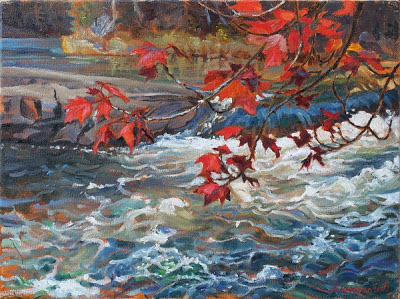Philomycus togatus, the Toga Mantleslug
Another slug painting, this one I expected to be difficult, as it is deliberately indistinct in pattern - obviously trying to look like a bird dropping, decomposing fungus, or some other bit of organic muck. Philomycus is a forest slug, and there are other species, but in the east we have only togatus.
I found this one resting in the shadow of a well-rotted, mossy branch of White Birch on the forested southeast facing slope just above a newly gravelled laneway leading into a recently surveyed potential cottage lot. Fred is checking a block of four surveyed lots for the presence of Black Rat Snakes on the shore of Big Rideau Narrows, across from Murphys Point Provincial Park, and I accompanied him on his first visit to the site.
The ground was dry, as it has been unseasonably warm and sunny for early May - and I was surprised to find the slug so exposed. It was lying full length but with eye stalks retracted, and when I touched it to see whether it could be roused into activity, it curled itself into a semicircle and lay there inert, looking ever so much like a bird dropping. Its foot is pinkish and its mantle completely covers its body. I spent some time photographing it like that, waiting for it to relax and become active, but it was determinedly shy, so I collected some moss, cedar litter, and a curl of birch bark into a container, transferred the slug, and carried it home, without asking its leave.
It spent a week in the fridge, moving about on and under the moss, and nibbling on a slice of commercial mushroom. I finally got it out to paint, yesterday, and found it not as shy as I'd expected. It crawled all over the curl of birch bark as I held it in my left hand, drawing and painting with my right. When I had to leave my painting I set the bark down in a puddle of water in a glass dish, and covered it with a smaller glass dish.
I noticed that as the slug extends its body to its full 45mm length, the tip of its tail, a smooth grey nub with a midline slit, protrudes from under the posterior end of the mantle. Observed from the side, the pale pinkinsh foot is visible beneath the mantle edge, and it has tiny dots of orange, presumably pores for mucous, which is said to be orange. The eye stalks are stubby and dark blueish gray, becoming black at the tips, and the small, "taster" tentacles by its mouth point downward rather than forward. The mantle is brown, speckled with black (darker near the head), and has two lateral stripes of dark brown, streaked and flecked with black. The texture of the mantle is swirled like fingerprints at the head, and more longitudinally ridged farther back, becoming finer-textured toward the tail. When touched, all mantle texture disappears as the surface is flooded with a clear slime which makes the creature impossible to pick up.
I spent most of the day working with my live Philomycus togatus, first photographing it as it crawled on the bark, then measuring it and drawing it in pencil, then colouring the pencil drawing in watercolour. The highlights of the mantle texture were difficult to portray as distinctly as I would have liked - on such a busily but indistinctly-patterned surface.



Comments
Post a Comment
What do you think of this painting, and what do you know about the subject that I have painted?